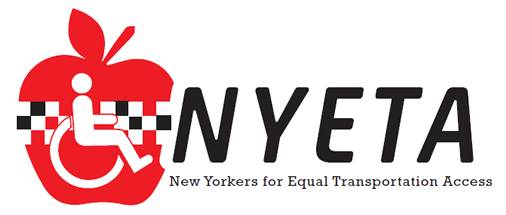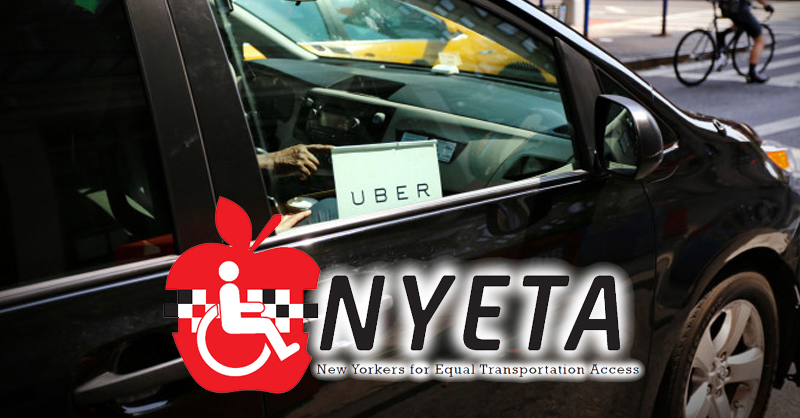PRESS ADVISORY
For Immediate Release
Disability Advocates Demand that the MTA Cease and Desist
Collaborating with Uber on Paratransit
“Don’t Reward Companies that Discriminate Against the Disability Community”
Contact: Nicole Epstein 516-880-8170; 718-309-7763
On Tuesday, December 13rd, advocates, medallion owners, and elected officials will call out the MTA for involving Uber in an effort to make the agency’s paratransit program more efficient and cost effective. Uber has a long record of ignoring the needs of people with disabilities and has not had, until very recently, a single accessible car for hire on the road in NYC in its entire fleet of 44,000 cars. In addition, while NYC taxis—both green and yellow—pay 50 cents into the MTA’s mass transit fund, Uber does not pay into the system at all—making the company a free rider that should not be rewarded for stiffing mass transit riders and discriminating against people with disabilities.
Where: 1 Centre Street, 19th floor, in large conference room
When: 2:00 PM
Who: Leaders of advocacy groups for people with disabilities; immigrant taxi medallion owners; and elected officials
Date: December 13, 2016
Background
The MTA is considering including Uber in its Access-a-Ride program. Uber operates over 44,000 vehicles in NYC and, until the company hatched a scheme to poach 40 accessible green taxis from the boroughs, not a single one was accessible to wheelchair users.
The addition of 40 accessible taxis to the Uber fleet—cabs that will now not be available to meet the needs of people with disabilities in the Bronx, Brooklyn, and Queens—means that .0009% of the Uber complement of cars for hire with be accessible. Even as it tries to appear good, Uber manages to further undermine the infrastructure of accessible taxis—and the programs designed to utilize them.
Three years ago, a lawsuit between the disability community and NYC was settled when Mayor Bloomberg agreed that the Taxi and Limousine Commission (TLC) would ensure that 50% of yellow cabs would be accessible by 2020. Four years ago, Governor Cuomo and the State Legislature authorized the sale of 2,000 new yellow taxi medallions, all of which had to be placed on wheelchair accessible vehicles. Additionally, the legislation created the green taxi street hail program for outer borough residents. Twenty percent of Boro taxis have to be accessible as well. The plan was to expand the fleet from 13,000 yellows to 15,000 yellows.
The success of Uber, Lyft, and other TNCs threatens the plan to provide accessible taxi service. Only 350 medallions of the 2,000 planned to be released for sale have been sold. No medallions have been sold at all for almost two years because there is no market for them.
Medallions that once sold for a million dollars have become worthless. The yellow cab fleet is shrinking as drivers and passengers migrate to the inaccessible vehicles operated by Uber and the other TNCs. Accessible taxis are being taken out of service, the size of the yellow fleet is shrinking for the first time in history, and demand for Access-a-Ride, which could have been reduced because of the availability of spontaneous, door-to-door accessible transportation offered by taxis, will increase at great cost to tax payers.
MTA could help solve this problem by refusing to do business with companies that are inaccessible to wheelchair users. Instead of giving an Access-a-Ride contract to Uber to provide rides to non-wheelchair using passengers (cognitively impaired, blind, frail, etc.), MTA should state that they will not do business with companies that discriminate on the basis of disability.
Mayor De Blasio’s Traffic Congestion Study, released last year, stated:
“The City can expand the reach of accessible for-hire service by identifying ways to improve coordination between the TLC’s growing accessible taxi program and the MTA’s current Access-A-Ride system. The City’s accessible yellow and green taxis can help to provide greatly enhanced and more efficient service for Access-A-Ride users. The City and the MTA should continue to work together towards that end.”
Keep in mind that the TLC’s citywide dispatch service for wheelchair accessible taxis has so far shown real signs of success—featuring on demand service that allows people with disabilities to travel when they want. According to the TLC, current wait times do not exceed 12 minutes! (http://www.accessibledispatch.com/how-it-works/)
The MTA, rather than trying to reinvent the wheel when an attractive alternative exists, should collaborate with the TLC and seek to replicate this service for its Access-A-Ride users. The mayor’s study also dramatized the zero-sum game that is being played when the TLC and the MTA aggrandize the very companies that threaten the existing accessible vehicle infrastructure:
“As more e-dispatch vehicles are added to the road, the number of accessible yellow and green taxis becomes a smaller and smaller percentage of all for-hire vehicles – even without the drop in supply of yellow and green taxi drivers that the City is beginning to experience.”
Remember –
(1) Uber is not required to contribute 50 cents per ride to MTA, as yellow and green cabs do. In 2015, there were on average 400,294 taxi trips in NYC generating $73,053,655 for mass transit over the course of the year. This is a drop of 52,046 daily trips from the previous year because of lost rides to the TNCs—a yearly loss of revenue to the MTA of close to $10,000,000. http://www.nyc.gov/html/tlc/downloads/pdf/2016_tlc_factbook.pdf
(2) Uber is not required to contribute 30 cents per ride to the Taxi Improvement Fund to offset the cost associated with purchasing accessible vehicles, as yellow and green cabs do. As fares have navigated to the TNCs, the resulting loss to the Taxi Improvement Fund for accessible cabs is approx. $5,700,000
(3) Half of the yellow fleet will be accessible by 2020 and readily available to MTA to use as Access-a-Ride carriers. About 1,000 are on the street now.
(4) The green taxi program has been decimated by Uber, undermining accessibility to the boros and harming the investments of thousands of immigrant entrepreneurs who believed that the program would be supported by the City of New York. (http://www.crainsnewyork.com/article/20160925/SMALLBIZ/160929932/the-great-green-cab-experiment-is-on-the-brink-of-crumbling-against-uber-and-wheelchair-accessibility-requirements-that-many-green-cab-operators-say-randomly-change; http://www.nydailynews.com/new-york/plan-nyc-green-taxi-program-expansion-stalls-article-1.2606365 )
What needs to be done
- If Uber wants to do business in NYC, it should serve all citizens, not just those who can walk. Uber’s business model does not include wheelchair users by design. MTA can help force Uber to become accessible;
- The MTA and the TLC should work together to connect the TLC’s promising on demand city wide dispatch program with Access-A-Ride. (http://www.nyc.gov/html/tlc/downloads/pdf/accessible_taxi_user_guide.pdf)


Recent Comments